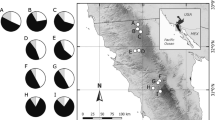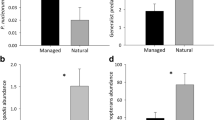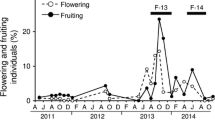Summary
Pre-dispersal seed predation of the leguminous Acacia farnesiana by Mimosestes nubigens and M. mimosae (Coleoptera: Bruchidae) was investigated in Santa Rosa National Park, northwestern Costa Rica. The purpose of the study was to determine the patterns of resource utilization by the seed predators and the mechanisms causing such patterns. Immature, mature, and fallen fruits were monitored during the dry seasons of 1987 and 1988 from different shrubs and areas. Parameters describing plant size, fecundity, and relative plant isolation were measured on each shrub. No evidence of spatial or temporal segregation was found between the two species and the intensity of seed predation was independent of the variables measured from each plant. M. mimosae was scarcer and always occurred with M. nubigens. Both were present in areas with low and high densities of the host plant, and the frequency distributions of their emergences from the fruits overlapped through the fruiting season. urosigalphus sp., a hymenopteran parasitoid, represented ca. 40% of all insect emergences in 1987 and ca. 30% in 1988. This wasp attacked a greater proportion of bruchid eggs on pods on the shrub than on pods beneath it, and more on green than on mature fruits. Parasitism thus appears to select against bruchid females that oviposit at an early stage of pod maturation. The harsh conditions of the dry season, namely heat and desiccation, also accounted for a high level of bruchid pre-emergence mortality, especially in fallen fruits, where survival from egg to adult was only about 18%. Beneath the shrubs, bruchid females exhibited selectivity, ovipositing more on pods in the shade than on those exposed to direct sunlight. In contrast to parasitoids, abiotic factors probably impose a selective force against those bruchid females that oviposit at a late stage of maturation or on pods already dropped. Both bruchid species can have more than one generation during the fruiting period. The intensity of seed predation did not, however, change during the season. The data obtained in this study suggest that factors like natural enemies and severe weather are more likely to limit the bruchid population densities than intra- or interspecific competition.
Similar content being viewed by others
References
Bridwell JC (1920) Notes on the Bruchidae (Coleoptera) and their parasites in the Hawaiian Islands. Proc Hawaii Entomol Soc 4:403–409
De Steven D (1981) Predispersal seed predation in a tropical shrub (Mabea occidentalis, Euphorbiaceae). Biotropica 13:146–150
De Steven D (1983) Reproductive consequences of insect seed predation in Hammamelis virginiana. Ecology 64:89–98
Fritz RS, Gaud WS, Sacchi CF, Price PW (1987) Patterns of intra- and interspecific association of gall-forming sawflies in relation to shoot size on their willow host plants. Oecologia 73:159–169
Hartshorn GS (1983) Plants. Introduction. In: Janzen DH (ed), Costa Rican Natural History, Chicago University Press, Chicago, pp 118–157
Hinckley AD (1960) The klu beetle, Mimosestes sallaei (Sharp), in Hawaii. Proc Hawaii Entomol Soc 17:260–269
Hinckley AD (1961) Comparative ecology of two beetles established in Hawaii: an anthribid Araecerus levipennis and a bruchid Mimosestes sallaei. Ecology 42:526–532
Hopkins MJG (1983) Unusual diversities of seed beetles (Coleoptera: Bruchidae) on Parkia (Leguminosae: Mimosoideae) in Brazil. Biol J Linn Soc 19:329–338
Hopkins MJG (1984) The seed beetles (Bruchidae) of Parkia (Leguminosae: Mimosoideae) in Brazil: strategies of attack. In: Chadwick AC, Sulton SL (eds), Tropical Rain Forest, The Leeds Symposium, Leeds Phil Lit Soc, pp 139–145
Janzen DH (1971a) Seed predation by animals. Ann Rev Ecol Syst 2:465–492
Janzen DH (1971b) The fate of Scheelea rostrata fruits beneath the parent tree: predispersal attack by bruchids. Principes 15:89–101
Janzen DH (1975a) Interactions of seeds and their insect predators/parasitoids in a tropical deciduous forest. In: Price PW (ed), Evolutionary strategies of parasitic insects and mites, Plenum Press, New York, pp. 154–186
Janzen DH (1975b) Intra- and interhabitat variations in Guazuma ulmifolia (Sterculiaceae) seed predation by Amblycerus cistelinus (Bruchidae) in Costa Rica. Ecology 56:1009–1013
Janzen DH (1977) Intensity of predation on Pithecellobium saman (Leguminosae) seeds by Merobruchus columbinus and Stator limbatus (Bruchidae) in Costa Rican deciduous forest. Trop Ecol 18:162–176
Janzen DH (1980) Specificity of seed-attacking beetles in a Costa Rican deciduous forest. J Ecol 68:929–952
Janzen DH (1985) Spondias mombin is culturally deprived in megafauna-free forest. J Trop Ecol 1:131–155
Johnson CD (1980) Host preferences of Stator in nonhost seeds. Entomol Soc Am 10:857–863
Johnson CD (1981) Interactions between bruchid (Coleoptera) feeding guilds and behavioral patterns of pods of the Leguminosae. Entomol Soc Am 10:249–253
Johnson CD (1983) Mimosestes playazul, new species, with new host records for other Mimosestes (Coleoptera: Bruchidae). Ann Entomol Soc Am 76:816–820
Johnson CD (1984) New host records and notes on the biology of Stator (Coleoptera: Bruchidae). The Coleopt Bull 38:85–90
Johnson CD, Slobodchikoff CN (1979) Coevolution of Cassia (Leguminosae) and its seed beetle predators (Bruchidae). Environ Entomol 8:1059–1064
Juliano SM, Lawton JH (1990) The relationship between competition and morphology. II. Experiments on co-occurring dytiscid beetles. J Anim Ecol 59:831–848
Kingsolver JM, Johnson CD, Swier SR, Teran A (1977) Prosopis fruits as a resource for invertebrates. Simpson BB (ed), Mesquite, its biology in two desert scrub ecosystems, US/IBP Synthesis series 4, Dowden, Hutchinson & Ross, Stroudsburg, PA, pp 108–122
Lamprey HF, Halevy G, Makacha S (1974) Interactions between Acacia, bruchid seed beetles and large herbivores. E Afr Wildl J 12:81–85
Lawton JH, Gaston KJ (1989) Temporal patterns in the herbivorous insects of bracken: a test of community predictability. J Anim Ecol 58:1021–1034
Little EL Jr, Wadsworth FH (1964) Common trees of Puerto Rico and the Virgin Islands. U.S. Dept. Agric., handbook no. 249. Forest Service, Washington
Loreau M (1990) Competition in a carabid beetle community: a field experiment. Oikos 58:25–38
Messina FJ, Mitchell R (1989) Intraspecific variation in the eggspacing behavior of the seed beetle Callosobruchus maculatus. J Insect Behav 2:727–742
Mitchell R (1977) Bruchid beetles and seed packaging by Palo Verde. Ecology 58:644–551
Moore L (1978) Seed predation in the legume Crotalaria. II. Correlates of interplant variability in predation intensity. Oecologia 34:203–223
Pellmyr O (1989) The cost of mutualism: interactions between Trollius europaeus and its pollinating parasites. Oecologia 78:53–59
SAS Institute Inc. (1985) SAS User's Guide: Statistics, Version 5 Edition. SAS Institute Inc. Cary, NC
Strong DR, Lawton JH, Southwood R (1984) Insects on Plants. Community Patterns and Mechanisms, Harvard University Press, Cambridge, Mass
Traveset A (1989) Environmental and biological factors affecting the bruchid seed predators of Acacia farnesiana (L.) Willd. Dissertation thesis. University of Pennsylvania
Traveset A (1990a) Ctenosaura similis Gray (Iguanidae) acting as a seed disperser in a Central American deciduous forest. Am Midl Nat 123:402–404
Traveset A (1990b) Post-dispersal predation of Acacia farnesiana seeds by Stator vachelliae (Bruchidae) in Central America. Oecologia 84:506–512
Traveset A (1990c) Bruchid egg mortality caused by ants and abiotic factors in the leguminous Acacia farnesiana (L.) Willd. Ecol Entomol 15:463–467
Vandermeer JH (1974) Relative isolation and seed predation in Calliandra grandiflora, a mimosaceous legume from the highlands of Guatemala. Biotropica 6:267–268
Wilson K (1988) Egg laying decisions by the bean weevil Callosobruchus maculatus. Ecol Entomol 13:107–118
Author information
Authors and Affiliations
Rights and permissions
About this article
Cite this article
Traveset, A. Pre-dispersal seed predation in Central American Acacia farnesiana: factors affecting the abundance of co-occurring bruchid beetles. Oecologia 87, 570–576 (1991). https://doi.org/10.1007/BF00320422
Received:
Accepted:
Published:
Issue Date:
DOI: https://doi.org/10.1007/BF00320422




